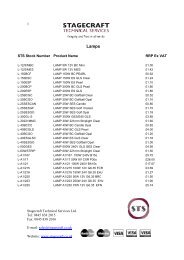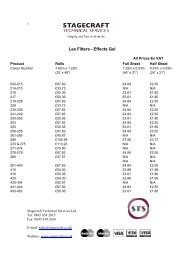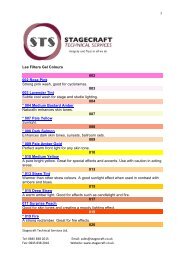You also want an ePaper? Increase the reach of your titles
YUMPU automatically turns print PDFs into web optimized ePapers that Google loves.
THE PERFORMANCE MEMORY SYSTEMThe icon is a programmable memory mixer. This lets you accurately recall previous settingswithout having to manually reset every control. The memory system is structured specificallyfor live performance. The memories also apply in theatre where scenes can be sequencedaccording to a cue sheet, or in multi-function venues such as clubs, schools and houses ofworship where settings change according to event or user. Three types are provided:• VENUE memories store the settings associated with how the mixer is set up for theperformance venue. This includes the amplifier configuration and graphic EQ settings.• SONG memories store the settings which are likely to change between songs or scenes.This includes the EQ, dynamics, effects, mutes and mix pan and level settings.• SET memories store the sequence of song memories for recall during live performanceusing panel or foot switches. A ‘set’ is the play list or order in which songs are to beperformed.You can decide how you want to use the Song memories. A ‘safes’ system lets you choosewhat parameters on which channels you want affected by the memories. You can, for example,use the system to recall effects and EQ changes on your guitar channel only rather thanoverwriting all your settings. This provides the system with huge flexibility.There are 19 Venue, 127 Song and 9 Set user memories. A special song memory known as thePAUSE patch toggles the mixer between the current settings and an alternative setting. This isnormally used for intermission chat between songs where it may be desirable for example toreduce the level of effects and mute some of the channels. Alternatively it could be used totoggle between two alternative settings for comparison, or used as a scratchpad memory. Paneland footswitch control is provided. Changes made to the current and pause patches do notneed to be stored. These settings and the contents of the memories are saved when the mixer isturned off.Each user memory can be given an 8 digit name which is displayed in large characters duringperformance. Selected memories can be locked for recall only so preventing accidentaloverwriting. An 8 digit user name can be entered for mixer and data archive identification.MIDI AND RS232MIDI in and out sockets are provided so that memories can be recalled using MIDI programchange messages, individual channels can be muted using note on/off messages, individualperformance parameters can be accessed using controller messages, and the user memories canbe archived using system exclusive MIDI dump. The RS232 connector allows connection tothe serial port of a personal computer for data archiving and downloading of future softwarereleases. Refer to the <strong>Allen</strong> & <strong>Heath</strong> Internet web site for the latest information and software.A rear panel selector switch determines whether the MIDI or RS232 interface is active.THE DP1000 POWER AMPLIFIERTwo power amplifiers are included in the DP1000 powered mixer. These each produce amaximum of 300 Watts into a minimum 4 ohms impedance. Outputs A and B benefit from the10-band graphic EQ and are fed to the amplifier inputs. These can be configured in one ofthree ways: stereo PA, mono PA with foldback monitor, or a larger system with two monitorsand an external PA amplifier. Speaker connections are the standard Speakon ® type. Theamplifier and associated power supply are a linear design with metal cased bi-polar powerdevices to ensure signal clarity and on the road reliability. Heat is dissipated and removedfrom the unit using a 3-speed fan which sucks air in from the front of the unit, blows it overthe circuits and down a purpose designed extruded heatsink funnel to the exhaust vents in theside. The fan blows briefly at full speed on power up to test and clear the system, then slowsto idle speed until a rise in temperature is detected. Loudspeaker protection is provided byrelays which disconnect the speakers if DC or excessive temperature is detected. These relaysalso delay speaker turn on for a few seconds on power up to allow the amplifier circuits tostabilise. A current limit circuit protects the amplifier from excessive loading or short circuits.1 - 6 icon SERIES









